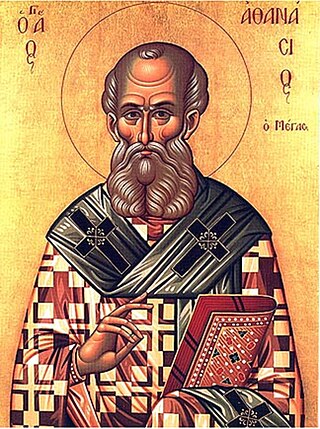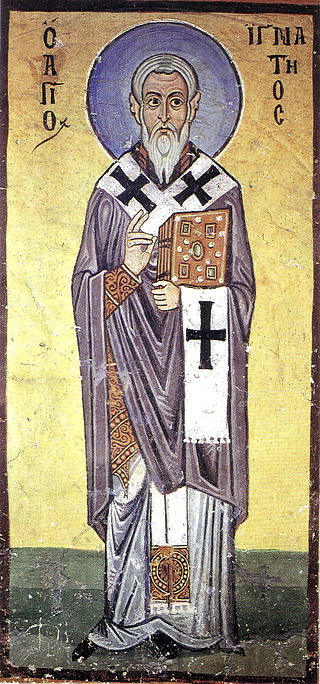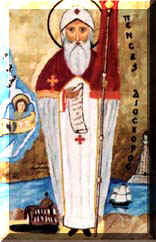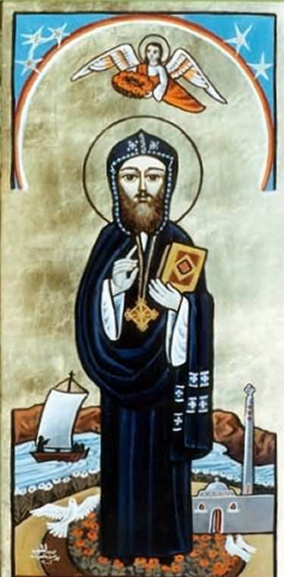Related Research Articles

Athanasius I of Alexandria, also called Athanasius the Great, Athanasius the Confessor, or, among Coptic Christians, Athanasius the Apostolic, was a church father and the 20th pope of Alexandria. His intermittent episcopacy spanned 45 years, of which over 17 encompassed five exiles, when he was replaced on the order of four different Roman emperors. Athanasius was a Christian theologian, a Church Father, the chief defender of Trinitarianism against Arianism, and a noted Egyptian Christian leader of the fourth century.

The Council of Chalcedon was the fourth ecumenical council of the Christian Church. It was convoked by the Roman emperor Marcian. The council convened in the city of Chalcedon, Bithynia from 8 October to 1 November 451 AD. The council was attended by over 520 bishops or their representatives, making it the largest and best-documented of the first seven ecumenical councils. The principal purpose of the council was to re-assert the teachings of the ecumenical Council of Ephesus against the heresies of Eutyches and Nestorius. Such heresies attempted to dismantle and separate Christ's divine nature from his humanity (Nestorianism) and further, to limit Christ as solely divine in nature (Monophysitism).

Ignatius of Antioch, also known as Ignatius Theophorus, was an early Christian writer and Patriarch of Antioch. While en route to Rome, where he met his martyrdom, Ignatius wrote a series of letters. This correspondence now forms a central part of a later collection of works known to be authored by the Apostolic Fathers. He is considered to be one of the three most important of these, together with Clement of Rome and Polycarp. His letters also serve as an example of early Christian theology. Important topics they address include ecclesiology, the sacraments, and the role of bishops.

The Council of Ephesus was a council of Christian bishops convened in Ephesus in AD 431 by the Roman Emperor Theodosius II. This third ecumenical council, an effort to attain consensus in the church through an assembly representing all of Christendom, confirmed the original Nicene Creed, and condemned the teachings of Nestorius, Patriarch of Constantinople, who held that the Virgin Mary may be called the Christotokos, "Christ-bearer" but not the Theotokos, "God-bearer". It met in June and July 431 at the Church of Mary in Ephesus in Anatolia.

Nestorius was the Archbishop of Constantinople from 10 April 428 to August 431. A Christian theologian, several of his teachings in the fields of Christology and Mariology were seen as controversial and caused major disputes. He was condemned and deposed from his see by the Council of Ephesus, the third Ecumenical Council, in 431.
Epiphanius was the Ecumenical Patriarch of Constantinople from February 25, 520 to June 5, 535, succeeding John II Cappadocia.

Anatolius was a Patriarch of Constantinople. He is regarded as a saint, by both the Orthodox and Roman Catholic Churches.
Jacob Baradaeus, also known as Jacob bar Addai or Jacob bar Theophilus, was the Bishop of Edessa from 543/544 until his death in 578. He is venerated as a saint in the Oriental Orthodox Churches and his feast day is 31 July. Jacob's missionary efforts helped establish the non-Chalcedonian Syriac Orthodox Church, also known as the "Jacobite" Church after its eponymous leader, and ensured its survival despite persecution.
Maximianus was the archbishop of Constantinople from 25 October 431 until his death on 12 April 434.

Dioscorus I, also known as Dioscorus the Great, was the pope of Alexandria and patriarch of the See of St. Mark who was deposed by the Council of Chalcedon in 451. He was recognized as patriarch by the Coptic Church until his death. He died in Gangra, Paphlagonia, in September 454. He is venerated as a saint by the Coptic and other Oriental Orthodox Churches.

Severus the Great of Antioch, also known as Severus of Gaza or Crown of Syrians, was the Patriarch of Antioch, and head of the Syriac Orthodox Church, from 512 until his death in 538. He is venerated as a saint in the Oriental Orthodox Church, and his feast day is 8 February.
Novatian was a scholar, priest, and theologian. He is considered by the Catholic Church to have been an antipope between 251 and 258. Some Greek authors give his name as Novatus, who was an African presbyter.

Pentarchy is a model of Church organization formulated in the laws of Emperor Justinian I (527–565) of the Roman Empire. In this model, the Christian church is governed by the heads (patriarchs) of the five major episcopal sees of the Roman Empire: Rome, Constantinople, Alexandria, Antioch, and Jerusalem.
Mallus was an ancient city of Cilicia Campestris lying near the mouth of the Pyramus river, in Anatolia. In ancient times, the city was situated at the mouth of the Pyramus, on a hill opposite Magarsa which served as its port. The district was called from it, Mallotis. The location of the site is currently inland a few km from the Mediterranean coast on an elevation in the Karataş Peninsula, Adana Province, Turkey, a few km from the city of Karataş.
The Second Council of Ephesus was a Christological church synod in 449 AD convened by Emperor Theodosius II under the presidency of Pope Dioscorus I of Alexandria. It was intended to be an ecumenical council, and it is accepted as such by the miaphysite churches but was rejected by the Chalcedonian dyophysites. It was explicitly repudiated by the next council, the Council of Chalcedon of 451, recognised as the fourth ecumenical council by Chalcedonian Christians, and it was named the Latrocinium or "Robber Council" by Pope Leo I; the Chalcedonian churches, particularly the Roman Catholic and Eastern Orthodox communions, continue to accept this designation, while the Oriental Orthodox repudiate it.
Saint Ephraim of Antioch, also known as Saint Ephraim of Amida, was the Patriarch of Antioch, and head of the Greek Orthodox Church of Antioch, from 527 until his death in 545. He is venerated as a saint in the Eastern Orthodox Church and Roman Catholic Church, and his feast day is 8 June.
Paul II the Black, also known as Paul of Bēth Ukkāme, was the Patriarch of Antioch and head of the Syriac Orthodox Church from c. 551 or 564 to his deposition in 578. He succeeded Sergius of Tella as the spiritual leader of the Syrian non-Chalcedonians, in opposition to the Chalcedonian Imperial Church, and led the nascent Syriac Orthodox Church as it endured division and persecution.

The East–West Schism that occurred in 1054 represents one of the most significant events in the history of Christianity. It includes various events and processes that led to the schism and also those events and processes that occurred as a result of the schism. Eastern and Western Christians had a history of differences and disagreements, some dating back to the period of Early Christianity. At the very root of what later became the Great Schism were several questions of pneumatology and ecclesiology. The most important theological difference occurred over various questions regarding the procession of the Holy Spirit, and the use of the filioque clause in the Nicene Creed. One of the main ecclesiological issues was the question of papal supremacy. Other points of difference were related to various liturgical, ritual, and disciplinary customs and practices. Some political and cultural processes also contributed to the breakout of the schism.
In Christianity, Church councils are formal meetings of bishops and representatives of several churches who are brought together to regulate points of doctrine or discipline. The meetings may be of a single ecclesiastical community or may involve an ecclesiastical province, a nation or other civil region, or the whole Church. Some of those convoked from the Church as a whole have been recognized as ecumenical councils and are considered particularly authoritative. The first ecumenical council is that of Nicaea, called by the Emperor Constantine in 325.
Augusta was a town in the interior of ancient Cilicia, inhabited during Roman and Byzantine times. It was founded in 20 AD and named after Livia, the widow of the Emperor Augustus. Ptolemy places this town in a district named Bryelice. The town also bore the name Augustopolis, and possibly Thebae.
References
- ↑ Charles Joseph Hefele, A History of the Councils of the Church: from the Original Documents, to the close of the Second Council of Nicaea A.D. 787 (Wipf and Stock Publishers, 1 Feb 2007) page 126.
- 1 2 Henry Wace, Dictionary of Christian Biography and Literature (Delmarva Publications, Inc., 1911)
- ↑ Adam M. Schor, Theodoret's People: Social Networks and Religious Conflict in Late Roman Syria (University of California Press, 17 May 2011) page 102-103.
- ↑ John Fulton, Index Canonum: The Greek Text, an English Translation, and a Complete Digest of the Entire Code of Canon Law of the Undivided Primitive Church (Wipf and Stock Publishers, 16 Sep 2014) page 151.
- ↑ Edward Ambrose Burgis, The annals of the Church (E.A. Burgis, 1738) page 172-173.